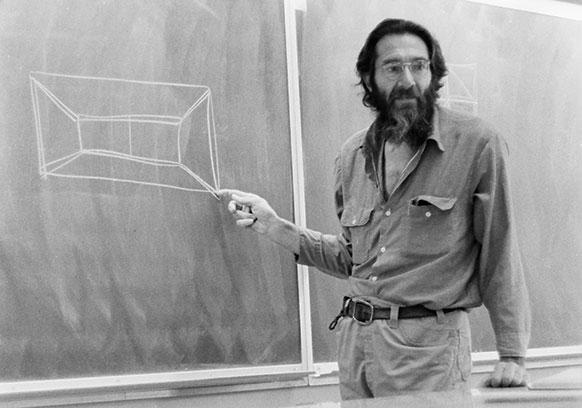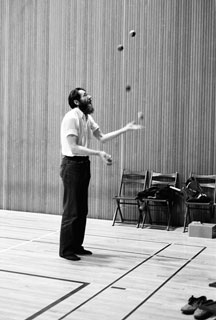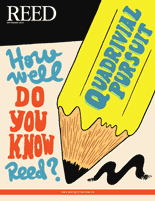
IRIS login | Reed College home Volume 93, No. 3: September 2014
Prime Exponent

photo by Kathy Reyes
Iconic math professor Joe Roberts retires after teaching for ((2^2)^3)-2 years.
By Bill Donahue
Warning: This story may cause anguish for some readers. It may spur haunting memories or induce perspiration, loss of sleep, indigestion, gnashing of teeth, and a generalized sense of anomie. Physical reactions will vary. More predictable is this: few readers will entirely grasp this story’s subject matter. This piece is about the construction of the real numbers. It is about the teaching of theoretical mathematics at Reed, and also about how Reed’s introductory math course evolved under the wise and benevolent guidance of the college’s most looming and inscrutable scholar. Let us begin. Let us go back in time.
![]()

September 1952. A lean and sinewy new math professor strides onto the Reed campus, clad in white shirt and thin tie. Twenty-eight years old, six feet three inches tall, a high-school track star with the imposing brow of William Hartnell (the first Doctor Who), he cuts a formidable figure. His intellectual background is no less impressive. He holds degrees in chemistry and mathematics from Case Western and the University of Colorado, and spent a couple of years researching mathematical biology at the University of Chicago with the influential biophysicist Nicholas Rashevsky. He was a one-man math and chemistry department at the University of Wyoming in Sheridan. During World War II, he worked as a chemist in the plutonium plant at the Los Alamos National Lab. He was there in New Mexico when Oppenheimer watched his first mushroom cloud explode over the desert.
But the most important thing about Joe is that, throughout his childhood, his mother was the editor of Ohio Motorist magazine. He had ample time to roam, unsupervised, through the wastelands of east Cleveland. “I used to like to play along the railroad tracks in empty fields,” he remembers. “I liked to crawl through the tall grass and be hidden.” In high school, Joe and a friend often rummaged through the trash heaps outside an electrical company, looking for transformers and fluorescent tubes. “I remember my friend working with one tube that didn’t have any fluorescent stuff on the inside,” he says. “He became blinded for three days. Very frightening. I remember getting a bottle of mercury, and we used to play with that, too.” One evening, Joe’s mom came home to find that he had hooked up rubber hosing from the kitchen stove into his bedroom, so he could operate a Bunsen burner there. “That didn’t last long,” he remembers.
But in time the notion of play would become central to his mathematical schema. Joe’s a specialist in number theory, sometimes called “higher arithmetic,” the branch of mathematics concerned with the properties of whole numbers. In his 1992 book, Lure of the Integers, Joe eschews “serious mathematics” and instead champions “recreational” math, noting, “A mathematician working on a problem does not proceed in a straight path. . . . Even the day-to-day research work is often directed by chance: by what was done rather than what was attempted, by the content of last week’s colloquium, by a chance remark by a colleague or student.”
Joe wrote his book, he said in the preface, for “anyone interested in numbers.” At Reed, he yearned to grow such inquisitive characters. But in 1952 the college was entrenched in a stolid and practical approach to mathematics. For 32 years, Reed had used, as its first-year textbook, An Introduction to Mathematical Analysis, written by Prof. F.L. Griffin [math 1911–56] in 1921. The book was filled with equations useful to physics and chemistry students.
“I felt we needed do something more theoretical,” says Joe, “that we needed to introduce more rigor early on because we weren’t asking students to look carefully at how the numbers system works until junior year, when they studied advanced algebra.”
In 1956, Joe began writing notes for a course that would introduce freshmen to the timeless verities of mathematics. He would lead them into number theory by constructing the real numbers—out of thin air, almost. Math 11 would ask deep questions about why 1+1=2 and how an axiom functions. The class was highly abstract. For the first semester, actual digits (1, 2, 3, et cetera) were rarely used; symbols like x, y, and ∆ prevailed. “You try to build a complete set of objects called real numbers,” Joe says, recalling the notes. “You start with positive numbers, whole numbers, then you go to negative numbers, then fractions. Those are examples of rational numbers. Then you look at irrational numbers. The name itself tells you what the first mathematicians thought of those numbers. They’re irrational?”
Joe saw Math 11 as “a cultural course” that introduced students to the language and concepts of mathematics. He insisted that the class required no foreknowledge, but for many students Math 11 (it would become Math 111 in 1961) was nigh impossible. Sandeep Kaushik ’89 describes students taking Joe’s exams with a horrorstruck compound adjective: “utterly-defeated-and-couldn’t-solve-a-single-question-correctly.” He remembers scoring below 15% on two tests, even as he notched a B+.
It’s almost certain that no other U.S. college taught math so abstractly. When the esteemed number theorist and Yale professor Serge Lang heard about the class, he was so appalled that he wrote a letter of complaint to Reed’s president.
Still, others loved Math 11 precisely because it was abstract. “Everything Joe did had an aesthetic principle to it,” says Herschel Snodgrass ’59, a physics professor at Lewis & Clark. “His teaching was poetry.” Even the confused have fond memories. “I thought Joe Roberts was an incredibly cool, almost mystical figure,” says Sandeep. “He had this kind of soft-spoken Zen-like equanimity to him. He was a math saint who lived in a sanctified world of numbers.”
![]()
Okay, hold onto your hats. We’re about to leap forward 62 years. We’re hitting fast-forward, and in the whir of the videotape we see Joe Roberts leading student hikers up Mount Hood. We see the Reed faculty joining together, circa 1965, to help a colleague move out of his house. We see Joe walking into the kitchen, bending low, squatting, and hoisting the refrigerator on his back and out to the street. . . .
![]()
March 2014. Joe Roberts is sitting in his office, and he is about to retire. He is 90 years old now, and he has been teaching at Reed for 62 years, longer than any other professor in the college’s history. Through some trick of time, his appearance has not changed a whit since 1976. In a math department known for its hoary beards, Joe is the consummate wise man. He has a long white beard and he wears, as he has for decades, jeans, a flannel shirt, and scuffed work boots. By now, he has published three books and served roughly 100 students as thesis adviser. His specialty is teaching, and he has gone deep in that pursuit. His 375-page textbook, Elementary Number Theory, published in 1977, elegantly synthesized cutting-edge research to deliver a series of difficult algebraic problems. It was rendered in calligraphy by Gregory Maskarinec ’74.
Still, when he’s confronted with former students’ starry-eyed praise, he just shrugs. “Reed graduates always tend to color things,” he says to a visiting journalist. “They just make everything sound wonderful.”
“But you’ve done some amazing things here. Like what about lifting those refrigerators?”
“Empty. Those were empty refrigerators.”
Joe has never been one to aggrandize himself. Which is not to say that he’s meek. “He didn’t mince words,” says Prof. Hugh Chrestenson [mathematics 1957–90], remembering the ’50s at Reed. “Everyone knew he loved the Reed canyon, and whenever the groundskeepers were about to cut down a tree there, they’d say, ‘Wait. We better run that by Joe Roberts first.’”
Over the years, Joe has frequently spoken out on matters of conscience. In the mid-1950s, when F.L. Griffin, then acting as president, expelled a female student for living off-campus with a man who was not her husband, Joe wrote a letter of protest—and then he held his ground when Griffin got angry. He was unwavering in opposition to the Vietnam War and to both Gulf Wars, and he has no traffic with academia’s fixation on credentials. In discussing the placement of Reedies in graduate school, he says, “Oh, you mean the Rhodes scholarships and all that baloney?” He contains conviction, but his manner is wry and down-to-earth. There are few people more casual than Joe Roberts, and now two other distinguished professors drift into his office.
Prof. Ray Mayer [mathematics 1974–2002] sits down by the blackboard. Prof. Tom Wieting [mathematics 1965–] takes the Barcalounger, and suddenly it’s like three old guys hanging out at the doughnut shop, except that their dialogue is rarefied. “Do you remember that article from the November 1947 issue of Mathematical Monthly?” Wieting asks.
Everyone does, but the chat soon homes in on a long-departed colleague, Prof. William Lawvere [mathematics 1963–64], who, in his single year at Reed, upped the ante on Joe Roberts’ Math 111, rendering a new set of notes that were more abstruse. Now an emeritus professor at SUNY Buffalo, Lawvere is an expert in category theory, whose system reduces math to a collection of objects and arrows, like so:

As he considered Lawvere’s notes as a young professor, Mayer often felt lost in a mist of incomprehension. “His approach was all so formal,” he says. “It was very, very difficult, and it didn’t have a whole lot of meaning.”
“Well, I actually kind of liked it,” says Joe. “It was new to everybody. All the students were in the same boat.”
“And do you think you exposed them to beauty?” the journalist asks. “Is there a beauty to math?”
“Ray would do a better job with that question,” Joe says. “Ray?”
Ray Mayer is a slight man with a long white beard, and he is wearing a red chamois shirt and a tattered baseball cap. He says, “The first time I read Euclid, tears came to my eyes. It was so perfect, so beautiful.” His eyes are glistening even now, as he speaks, and a lovely peace fills the room as each of the three mathematicians recognizes, tacitly, that he has spent his life doing what he loves.
“I felt the same way, reading Euclid,” Joe says, “but I didn’t cry.”
![]()

Music of the spheres. Prof. Joe Roberts showed generations of Reed students how to play with numbers.
Photo by Kathy Reyes
Hit the rewind button. Go ahead. It’s like working with negative numbers. Now we see Joe Roberts in 1971 riding his bike across Canada, except that on our screen the bicycle is actually moving backwards, rear wheel first, and the cranks spin in reverse as Joe pedals up into the thin air of the Rockies. We see Joe playing Euclid’s Game with his students, teaching them that the difference of any two numbers is divisible by their greatest common denominator. We see the lesson backwards, naturally. The students become progressively stupider. The chalk disappears off the blackboard. . . .
September 1964. Freshman Cricket Parmalee ’67 takes Math 111, as devised by Joe Roberts. She is bewildered. When the class ends, Prof. Buzz Hunt [mathematics 1953–77] summons her to his office. “I know you’ve had some difficulty,” he says, “but I know you have it in you.” Hunt gives her an incomplete, telling her to finish the work on her own. “My heart sank,” Cricket remembers. For the next three years, she diligently avoids him wherever she’s on campus. “If I was going up the steps to the chapel and saw Dr. Hunt coming down,” she remembers, “I could just go down the hall, and up the other stairs. I got very good at this.”
But she needs the math credit to graduate, and finally in 1966 Joe and his math colleagues save her, by allowing non-majors to graduate so long as they take a class called “Math for Poets,” later known as “Math for Rocks.” She takes it; she passes. On graduation day, Hunt steps toward her, grinning. “Congratulations,” he says. “Now maybe we can stop avoiding each other.”
![]()
Fast-forward again, with the tape now whirring by Joe Roberts at a Reed party in 1985, crossing paths with a former student, Marguerite Cohen ’75. He says, “We should have dinner sometime.” “When?” she says. “How about tomorrow?” says Joe. They’re still married.
Now here is Joe in the Reed gymnasium, teaching one of Reed’s first juggling classes. He throws 1,2,3,4,5 balls up toward the ceiling and then he juggles them all, simultaneously, as the air before him becomes a bright, spinning blur. . . .
![]()
March 2014. “You know I can juggle a bit,” says the journalist. “I can do, like, three balls.”
“How about a piece of chalk, an eraser, and a pencil?” says Joe. “Can you juggle that?”
Joe’s just about to teach a class, Math 112, and soon the students filter in, pierced, tattooed, most of them less than double the square root of Joe’s age. One of them enters with a pair of shiny red headphones clamped to his skull. He is dancing and lip-synching with an urgency that calls to mind Justin Timberlake. Unfazed, Joe begins writing on the blackboard and soon the only sound is the clacking of chalk.
Today’s lesson involves Cauchy sequences wherein the various elements become increasingly close to one another. (An example Cauchy sequence is ½, -½, ¼, -¼, ⅛, -⅛
. . .). At the board, Joe becomes, well, not dewy-eyed but enchanted with the neat magic of the concept. “Now, what is the value of all x’s beyond that x,” he asks. “Won’t they be even closer to x?”
Reed stopped teaching freshmen how to construct the whole numbers in the early ’80s, but it has retained Joe’s rigorous, abstract approach to teaching math. “Relative to other professors, Joe’s approach is particularly theoretical,” says Prof. Albyn Jones [mathematics 1986–].
“Joe was tremendously inspiring to generations of Reed students for his gentle pedagogical style, his deep love of mathematics, his affection for pugnacious debates, and his unique (even for Reed!) iconoclastic worldview,” says Prof. Joe Buhler ’72 [mathematics 1980–2005]. “And perhaps also, at least when I was a student, his homemade beer.”
The concepts that interest Joe may be highly abstract, but his classroom style is downright folksy. In class, Joe discusses math’s great ideas as though they were so many scraps of metal malingering outside the electrical plant. He talks about the “upstairs” and “downstairs” of fractions, and at one point he asks, “Now if we have n pigeons and n - 1 holes, one hole’s gonna have two pigeons in it, right?” The room erupts in laughter.
Afterwards, Joe repairs to his office. “You know,” he says, “I really don’t want you to write this article. I don’t want any fuss about my retirement.”
“Well,” says the journalist, “maybe you could get yourself fired. That would put the kibosh on the story, I’m sure.”
There is a glimmer in Joe’s eyes. “And getting fired could be to my financial advantage,” he says. “I’d have to do the math on that one. Really,” he continues, “I don’t want any fanfare. I don’t want one of those luncheons they give people when they retire. Those luncheons are just so artificial. I think about the luncheon they’re going to give me and I almost want to work another year, just to avoid it. Really, I just want to turn the lights off and have everyone forget about me.”
Sorry, Joe. That’s not going to happen.
The headline in the print edition of this article mistakenly reported the length of time Joe taught at Reed, because of an elementary mathematical error committed by the editor (that's me). The headline implied that Joe taught at Reed for:
( 2 raised to the power of (2 raised to the power of 3) ) -2 = 254 years.
In fact, Joe taught for
( 2 raised to the power of 2 ) raised to the power of 3 ) -2 = 62 years.
Our sincere apologies for this exponential error.

LATEST COMMENTS
steve-jobs-1976 I knew Steve Jobs when he was on the second floor of Quincy. (Fall...
Utnapishtim - 2 weeks ago
Prof. Mason Drukman [political science 1964–70] This is gold, pure gold. God bless, Prof. Drukman.
puredog - 1 month ago
virginia-davis-1965 Such a good friend & compatriot in the day of Satyricon...
czarchasm - 4 months ago
John Peara Baba 1990 John died of a broken heart from losing his mom and then his...
kodachrome - 7 months ago
Carol Sawyer 1962 Who wrote this obit? I'm writing something about Carol Sawyer...
MsLaurie Pepper - 8 months ago
William W. Wissman MAT 1969 ...and THREE sisters. Sabra, the oldest, Mary, the middle, and...
riclf - 10 months ago